L'Oréal Bundle
Who Really Controls L'Oréal?
Ever wondered who steers the ship of the world's largest cosmetics company? Understanding the L'Oréal SWOT Analysis, and its ownership structure is key to grasping its strategic moves and market dominance. From its humble beginnings in 1909, L'Oréal has blossomed into a global beauty titan, but who exactly calls the shots today? This exploration unveils the intricate details of L'Oréal's ownership.
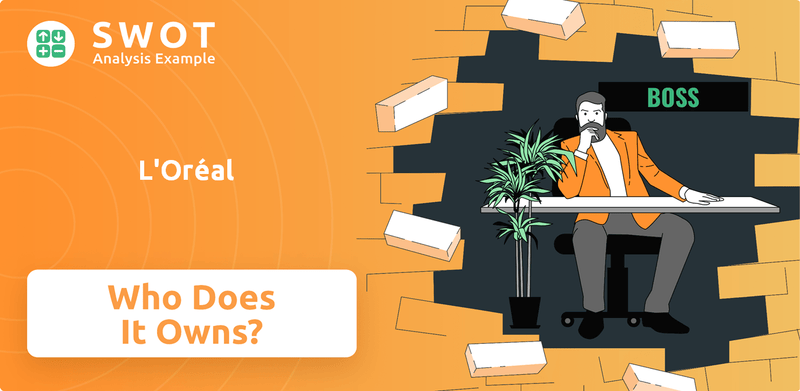
Unraveling the L'Oréal ownership reveals a fascinating story of family legacy, strategic investments, and public participation. This deep dive into L'Oréal's company structure will explore the evolution of its L'Oréal parent company and identify the key players shaping its future. Discover the answers to questions like "Who owns L'Oréal" and "Who is the major shareholder of L'Oréal," gaining insights into the company's governance and financial performance, and understanding the influence of L'Oréal shareholders.
Who Founded L'Oréal?
The story of L'Oréal begins with its founder, Eugène Schueller, a French chemist who established the company on July 30, 1909. Schueller's initial focus was on hair dyes, launching his first product, a synthetic hair dye named Auréole, which he sold to Parisian hairdressers. This marked the beginning of what would become a global beauty empire.
The early years saw the company registered as Société Française de Teintures Inoffensives pour Cheveux, reflecting its commitment to safe hair dyes. This foundational focus on hair care set the stage for L'Oréal's future growth and diversification within the beauty industry. The company's early success was built on innovation and a keen understanding of the evolving needs of its customers.
After Eugène Schueller's passing in 1957, his daughter, Liliane Bettencourt, inherited the company, becoming the largest shareholder. That same year, the company went public and was listed on the Paris Stock Exchange, a significant step in its evolution. This move opened up new avenues for investment and expansion, further solidifying L'Oréal's position in the market.
Eugène Schueller founded L'Oréal in 1909.
The first product was a hair dye called Auréole.
The company initially focused on safe hair dyes.
L'Oréal went public in 1957.
Liliane Bettencourt became the largest shareholder after her father's death.
A strategic partnership with Nestlé S.A. was established.
The ownership structure of L'Oréal has evolved significantly since its founding. The initial ownership was held by Eugène Schueller. After his death, Liliane Bettencourt inherited the majority stake. A pivotal moment in the company's history was the sale of a significant portion of shares to Nestlé S.A. in 1974. This move led to the creation of Gesparal, a holding company designed to protect L'Oréal from potential nationalization. This strategic decision highlights the complexities of L'Oréal's growth strategy and the factors influencing its ownership. Currently, the Bettencourt Meyers family, descendants of Liliane Bettencourt, remain the largest shareholders. Nestlé S.A. also holds a substantial stake, ensuring a balance of interests. The company is publicly traded, with a significant portion of shares available on the market, allowing for broader investor participation. The ownership structure of L'Oréal reflects a blend of family control, strategic partnerships, and public market participation.
- Eugène Schueller founded the company.
- Liliane Bettencourt became the largest shareholder.
- Nestlé S.A. acquired a significant stake.
- The Bettencourt Meyers family remains the major shareholder.
L'Oréal SWOT Analysis
- Complete SWOT Breakdown
- Fully Customizable
- Editable in Excel & Word
- Professional Formatting
- Investor-Ready Format
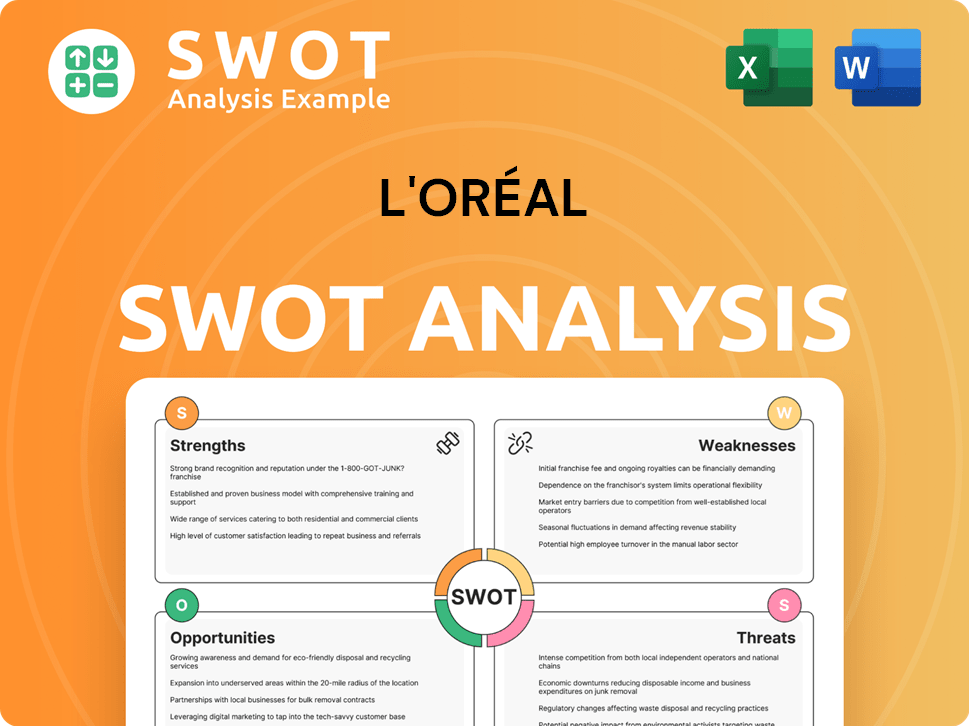
How Has L'Oréal’s Ownership Changed Over Time?
The evolution of L'Oréal's ownership has been marked by significant shifts. A key event was the establishment of the Gesparal holding company in 1974, which formalized the partnership between the Bettencourt family and Nestlé. This structure was later simplified in 2004 when Gesparal was absorbed by L'Oréal, making the Bettencourt family and Nestlé direct shareholders.
Following the 2004 restructuring, the Bettencourt family held a significant stake, alongside Nestlé. This restructuring also increased the voting rights of minority shareholders. The current ownership structure reflects a blend of family, corporate, and institutional investors, contributing to the company's long-term strategic direction and stability.
| Shareholder | Stake as of December 31, 2024 | Notes |
|---|---|---|
| Bettencourt Meyers Family (through Téthys SAS) | 34.76% | Largest shareholder |
| Nestlé S.A. | 20.14% | Second-largest shareholder |
| International Institutional Investors | 30.18% | Significant ownership |
| French Institutional Investors | 6.85% | |
| Individual Shareholders | 6.07% | |
| Employees | 2.00% |
As of December 31, 2024, the major stakeholders in L'Oréal include the Bettencourt Meyers family, holding the largest share, and Nestlé S.A. as the second-largest shareholder. The remaining shares are distributed among international and French institutional investors, individual shareholders, and employees. This diverse ownership structure highlights the balance between family influence, corporate involvement, and public market participation, influencing the company's strategic decisions and governance.
L'Oréal's ownership structure is a blend of family, corporate, and institutional investors, reflecting a long-term strategic vision. The Bettencourt Meyers family remains the major shareholder, followed by Nestlé. The company's history shows strategic partnerships and structural changes.
- The Bettencourt Meyers family holds the largest stake.
- Nestlé is the second-largest shareholder.
- A diverse group of institutional and individual investors hold the remaining shares.
- The ownership structure contributes to L'Oréal's stability and strategic direction.
L'Oréal PESTLE Analysis
- Covers All 6 PESTLE Categories
- No Research Needed – Save Hours of Work
- Built by Experts, Trusted by Consultants
- Instant Download, Ready to Use
- 100% Editable, Fully Customizable
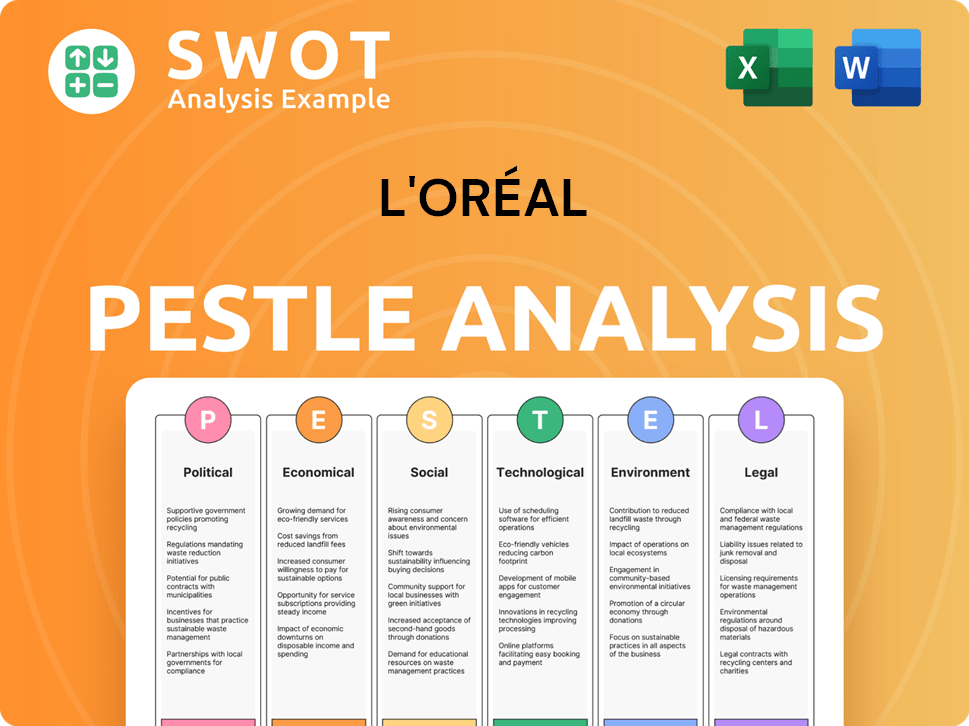
Who Sits on L'Oréal’s Board?
As of April 29, 2025, the Board of Directors for L'Oréal consists of 17 members, reflecting a blend of diverse representation and the company's unique ownership structure. The board includes the Chairman and Chief Executive Officer, alongside representatives from the Bettencourt Meyers family and Nestlé. Furthermore, there are independent directors and employee representatives, ensuring a variety of perspectives in decision-making. This structure is a key aspect of understanding L'Oréal's company structure and its governance.
The board's composition highlights diversity, with members from four different nationalities and a significant representation of women. Key figures include Jean-Paul Agon as Chairman of the Board, Nicolas Hieronimus as Chief Executive Officer, and Jean-Victor Meyers and Paul Bulcke as Vice-Chairmen. This structure helps in understanding who owns L'Oréal and how the company is governed.
| Board Member Role | Name | As of April 29, 2025 |
|---|---|---|
| Chairman of the Board | Jean-Paul Agon | Active |
| Chief Executive Officer | Nicolas Hieronimus | Active |
| Vice-Chairmen | Jean-Victor Meyers, Paul Bulcke | Active |
The Bettencourt Meyers family, as the major shareholder, holds significant influence. As of March 24, 2025, they held a 34.76% stake. While they have agreed not to exercise voting rights above 33.33% until the 2025 Annual General Meeting, their position provides considerable control. The total shares reported as of April 30, 2025, were 534,315,364, with 533,856,397 representing real voting rights. This information is crucial for anyone researching L'Oréal ownership and its financial performance.
The board's composition emphasizes diversity and includes key figures from major shareholders. The Bettencourt Meyers family's significant stake provides considerable control, even with limitations on voting rights. Understanding the board's structure is vital for grasping the dynamics of who owns L'Oréal.
- The board has 17 members as of April 29, 2025.
- The Bettencourt Meyers family holds a significant ownership percentage.
- The company has a total of over 534 million shares.
- The board includes independent directors and employee representatives.
L'Oréal Business Model Canvas
- Complete 9-Block Business Model Canvas
- Effortlessly Communicate Your Business Strategy
- Investor-Ready BMC Format
- 100% Editable and Customizable
- Clear and Structured Layout
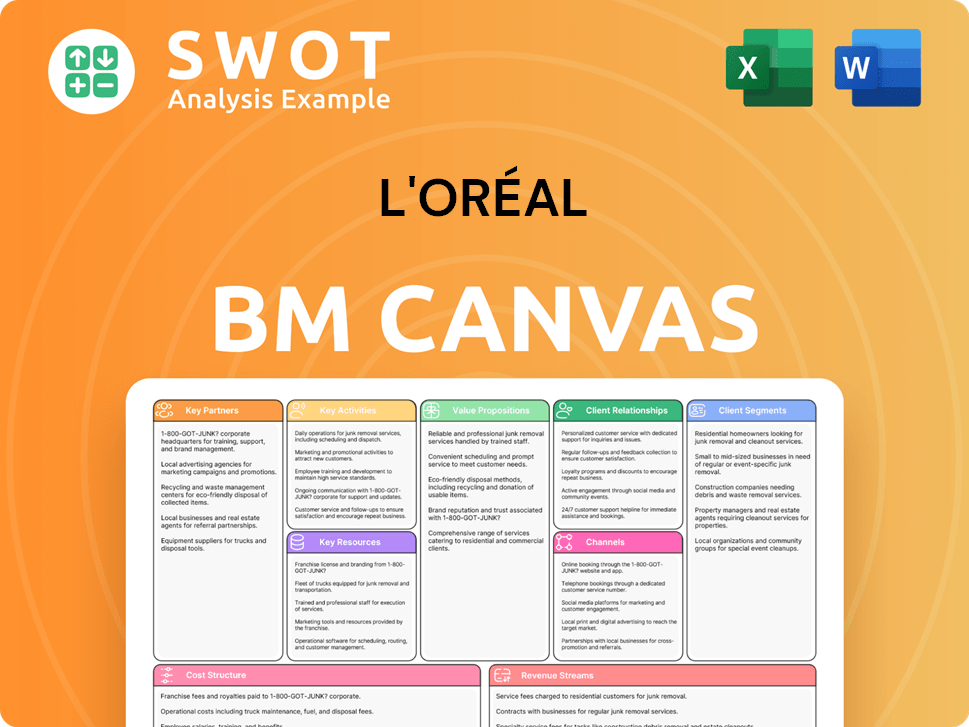
What Recent Changes Have Shaped L'Oréal’s Ownership Landscape?
Recent developments in the L'Oréal ownership structure highlight the continued influence of the Bettencourt Meyers family. As of March 24, 2025, the family held a 34.76% stake in the company. This strong position ensures family involvement in the company's strategic direction, with Jean-Victor Meyers succeeding his mother, Françoise Bettencourt Meyers, as Vice-Chairman in April 2025. The family's holding company, Téthys, is also proposed to join the board directly, reinforcing their control.
In addition to family involvement, L'Oréal has undertaken share buyback programs and strategic financial moves. A share buyback program was announced on April 1, 2025, for a maximum of €500 million, with up to 2 million shares to be acquired and cancelled by June 30, 2025. This action followed approval from the Annual General Meeting on April 23, 2024. Furthermore, in February 2025, L'Oréal sold a 2.3% stake in Sanofi for €3 billion, reducing its stake to 7.2%. These actions reflect L'Oréal's active management of its capital and investments.
L'Oréal also launched its fifth employee share ownership plan on June 10, 2025, offering employees in 62 countries the opportunity to purchase shares, with a maximum of 300,000 shares available. This initiative aims to boost employee participation in the company's success. Despite speculations, Nestlé remains a significant shareholder, holding a 20.1% stake valued at approximately US$47 billion as of September 2024. For more insights into the company's past, you can explore a brief history of L'Oréal.
| Key Ownership Developments | Details | Date |
|---|---|---|
| Bettencourt Meyers Family Stake | 34.76% | March 24, 2025 |
| Share Buyback Program | €500 million, up to 2 million shares | Announced April 1, 2025 |
| Sale of Sanofi Stake | 2.3% stake sold for €3 billion | February 2025 |
The Bettencourt Meyers family remains the largest shareholder, ensuring their influence over the company's strategic decisions. Nestlé holds a significant stake as well.
L'Oréal actively manages its capital through share buyback programs, which can impact the stock's value and shareholder returns. This includes the recent program announced in April 2025.
L'Oréal continues to make strategic moves, such as selling its stake in Sanofi, demonstrating its focus on portfolio optimization. These actions are part of their long-term strategy.
The employee share ownership plan promotes employee participation in the company's development, aligning their interests with the company's success. This initiative was launched on June 10, 2025.
L'Oréal Porter's Five Forces Analysis
- Covers All 5 Competitive Forces in Detail
- Structured for Consultants, Students, and Founders
- 100% Editable in Microsoft Word & Excel
- Instant Digital Download – Use Immediately
- Compatible with Mac & PC – Fully Unlocked
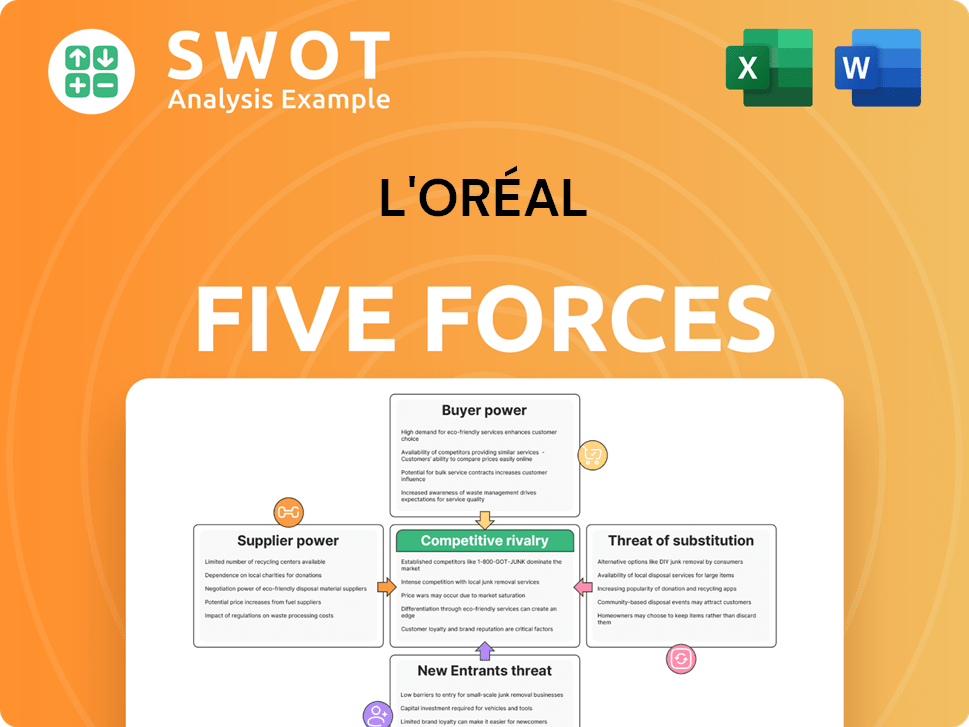
Related Blogs
- What are Mission Vision & Core Values of L'Oréal Company?
- What is Competitive Landscape of L'Oréal Company?
- What is Growth Strategy and Future Prospects of L'Oréal Company?
- How Does L'Oréal Company Work?
- What is Sales and Marketing Strategy of L'Oréal Company?
- What is Brief History of L'Oréal Company?
- What is Customer Demographics and Target Market of L'Oréal Company?
Disclaimer
All information, articles, and product details provided on this website are for general informational and educational purposes only. We do not claim any ownership over, nor do we intend to infringe upon, any trademarks, copyrights, logos, brand names, or other intellectual property mentioned or depicted on this site. Such intellectual property remains the property of its respective owners, and any references here are made solely for identification or informational purposes, without implying any affiliation, endorsement, or partnership.
We make no representations or warranties, express or implied, regarding the accuracy, completeness, or suitability of any content or products presented. Nothing on this website should be construed as legal, tax, investment, financial, medical, or other professional advice. In addition, no part of this site—including articles or product references—constitutes a solicitation, recommendation, endorsement, advertisement, or offer to buy or sell any securities, franchises, or other financial instruments, particularly in jurisdictions where such activity would be unlawful.
All content is of a general nature and may not address the specific circumstances of any individual or entity. It is not a substitute for professional advice or services. Any actions you take based on the information provided here are strictly at your own risk. You accept full responsibility for any decisions or outcomes arising from your use of this website and agree to release us from any liability in connection with your use of, or reliance upon, the content or products found herein.